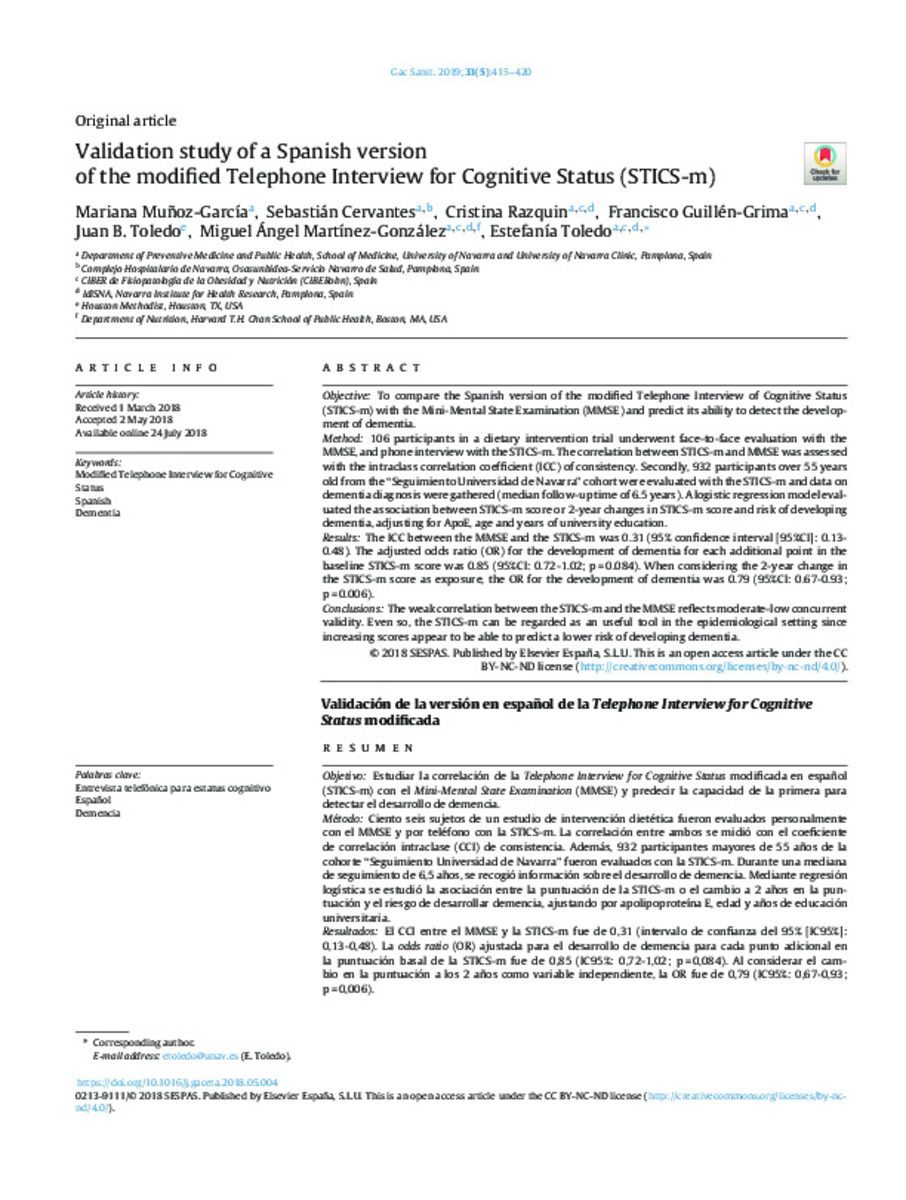Registro completo de metadatos
| Campo DC | Valor | Lengua/Idioma |
|---|---|---|
| dc.creator | Muñoz-García, M.I. (Mariana Isabel) | - |
| dc.creator | Cervantes-Ibáñez, S. (Sebastián) | - |
| dc.creator | Razquin, C. (Cristina) | - |
| dc.creator | Guillen-Grima, F. (Francisco) | - |
| dc.creator | Toledo, J.B. (J.B.) | - |
| dc.creator | Martinez-Gonzalez, M.A. (Miguel Ángel) | - |
| dc.creator | Toledo, E. (Estefanía) | - |
| dc.date.accessioned | 2022-06-01T12:09:52Z | - |
| dc.date.available | 2022-06-01T12:09:52Z | - |
| dc.date.issued | 2019 | - |
| dc.identifier.citation | Muñoz-García, M.I. (Mariana Isabel); Cervantes-Ibáñez, S. (Sebastián); Razquin, C. (Cristina); et al. "Validation study of a Spanish version of the modified Telephone Interview for Cognitive Status (STICS-m)". Gaceta Sanitaria. 33 (5), 2019, 415 - 420 | es |
| dc.identifier.issn | 0213-9111 | - |
| dc.identifier.uri | https://hdl.handle.net/10171/63591 | - |
| dc.description.abstract | Objective To compare the Spanish version of the modified Telephone Interview of Cognitive Status (STICS-m) with the Mini-Mental State Examination (MMSE) and predict its ability to detect the development of dementia. Method 106 participants in a dietary intervention trial underwent face-to-face evaluation with the MMSE, and phone interview with the STICS-m. The correlation between STICS-m and MMSE was assessed with the intraclass correlation coefficient (ICC) of consistency. Secondly, 932 participants over 55 years old from the “Seguimiento Universidad de Navarra” cohort were evaluated with the STICS-m and data on dementia diagnosis were gathered (median follow-up time of 6.5 years). A logistic regression model evaluated the association between STICS-m score or 2-year changes in STICS-m score and risk of developing dementia, adjusting for ApoE, age and years of university education. Results The ICC between the MMSE and the STICS-m was 0.31 (95% confidence interval [95%CI]: 0.13-0.48). The adjusted odds ratio (OR) for the development of dementia for each additional point in the baseline STICS-m score was 0.85 (95%CI: 0.72-1.02; p = 0.084). When considering the 2-year change in the STICS-m score as exposure, the OR for the development of dementia was 0.79 (95%CI: 0.67-0.93; p = 0.006). Conclusions The weak correlation between the STICS-m and the MMSE reflects moderate-low concurrent validity. Even so, the STICS-m can be regarded as an useful tool in the epidemiological setting since increasing scores appear to be able to predict a lower risk of developing dementia. | es_ES |
| dc.description.abstract | Objetivo Estudiar la correlación de la Telephone Interview for Cognitive Status modificada en español (STICS-m) con el Mini-Mental State Examination (MMSE) y predecir la capacidad de la primera para detectar el desarrollo de demencia. Método Ciento seis sujetos de un estudio de intervención dietética fueron evaluados personalmente con el MMSE y por teléfono con la STICS-m. La correlación entre ambos se midió con el coeficiente de correlación intraclase (CCI) de consistencia. Además, 932 participantes mayores de 55 años de la cohorte “Seguimiento Universidad de Navarra” fueron evaluados con la STICS-m. Durante una mediana de seguimiento de 6,5 años, se recogió información sobre el desarrollo de demencia. Mediante regresión logística se estudió la asociación entre la puntuación de la STICS-m o el cambio a 2 años en la puntuación y el riesgo de desarrollar demencia, ajustando por apolipoproteína E, edad y años de educación universitaria. Resultados El CCI entre el MMSE y la STICS-m fue de 0,31 (intervalo de confianza del 95% [IC95%]: 0,13-0,48). La odds ratio (OR) ajustada para el desarrollo de demencia para cada punto adicional en la puntuación basal de la STICS-m fue de 0,85 (IC95%: 0,72-1,02; p = 0,084). Al considerar el cambio en la puntuación a los 2 años como variable independiente, la OR fue de 0,79 (IC95%: 0,67-0,93; p = 0,006). Conclusiones La correlación débil entre la STICS-m y el MMSE refleja solo una moderada-baja validez concurrente. Aun así, la STICS-m puede considerarse útil en el contexto epidemiológico, ya que aumentos en la puntuación parecen predecir un menor riesgo de desarrollar demencia. | es_ES |
| dc.description.sponsorship | The SUN Project has received funding from the Spanish Government-Instituto de Salud Carlos III, and the European Regional Development Fund (FEDER) (RD 06/0045, CIBER-OBN, Grants PI10/02658, PI10/02293, PI13/00615, PI14/01668, PI14/01798, PI14/01764, and G03/140), the Navarra Regional Government (45/2011, 122/2014), and the University of Navarra. The PREDIMED Plus-NAVARRA trial has received funding from the European Research Council (Advanced Research Grant 2013-2018; 340918) granted to MAMG, the Instituto de Salud Carlos III (PI13/01090, PI16/01522) | es_ES |
| dc.language.iso | eng | es_ES |
| dc.publisher | Elsevier BV | es_ES |
| dc.rights | info:eu-repo/semantics/openAccess | es_ES |
| dc.subject | Modified telephone Interview for cognitive | es_ES |
| dc.subject | Status | es_ES |
| dc.subject | Spanish | es_ES |
| dc.subject | Dementia | es_ES |
| dc.subject | Entrevista telefónica para estatus cognitivo | es_ES |
| dc.subject | Español | es_ES |
| dc.subject | Demencia | es_ES |
| dc.title | Validation study of a Spanish version of the modified Telephone Interview for Cognitive Status (STICS-m) | es_ES |
| dc.title.alternative | Validación de la versión en espanol de la Telephone Interview for Cognitive Status modificada | es_ES |
| dc.type | info:eu-repo/semantics/article | es_ES |
| dc.description.note | This is an open access article under the CC BY-NC-ND license (http://creativecommons.org/licenses/by-ncnd/4.0/). | es_ES |
| dc.identifier.doi | 10.1016/j.gaceta.2018.05.004 | - |
| dadun.citation.endingPage | 420 | es_ES |
| dadun.citation.number | 5 | es_ES |
| dadun.citation.publicationName | Gaceta Sanitaria | es_ES |
| dadun.citation.startingPage | 415 | es_ES |
| dadun.citation.volume | 33 | es_ES |
Ficheros en este ítem:
Estadísticas e impacto
Los ítems de Dadun están protegidos por copyright, con todos los derechos reservados, a menos que se indique lo contrario.






